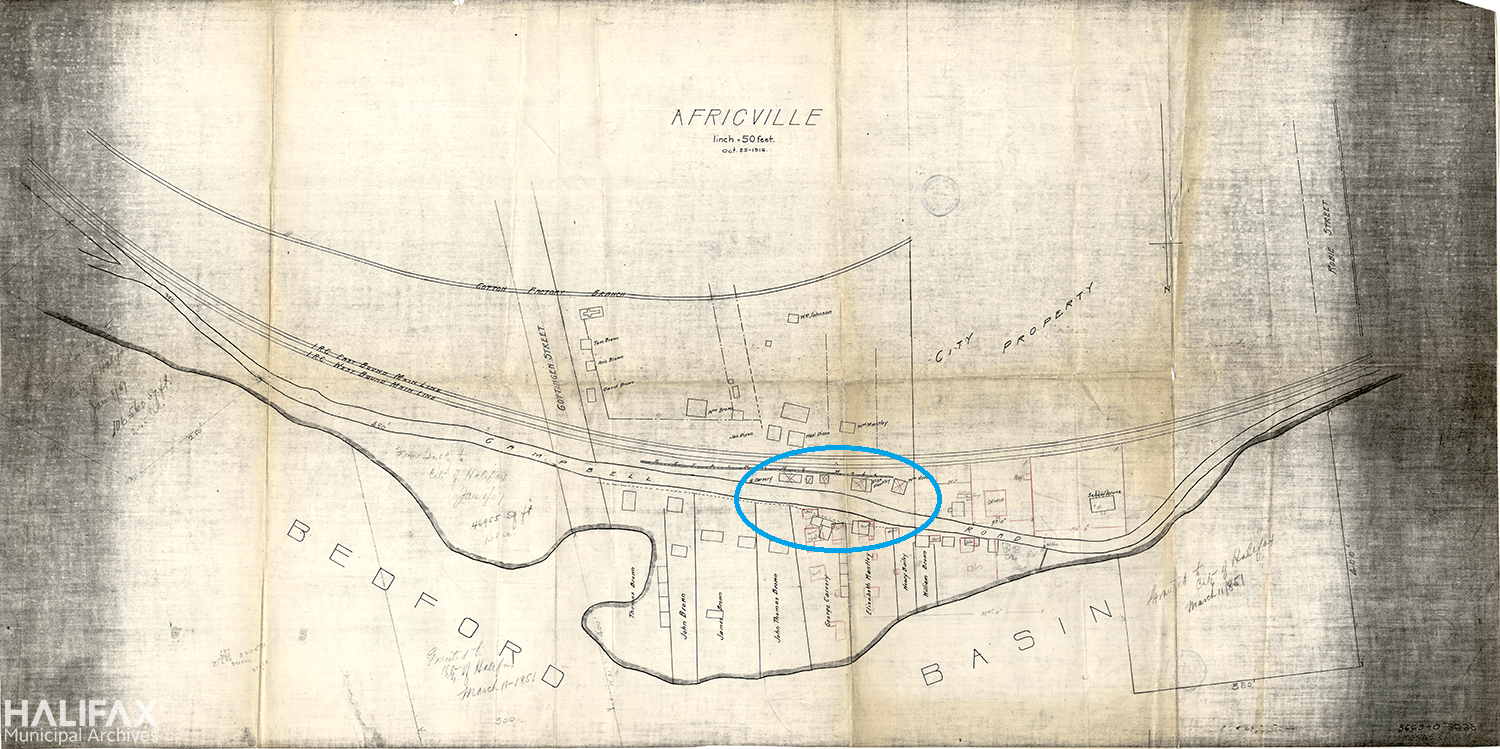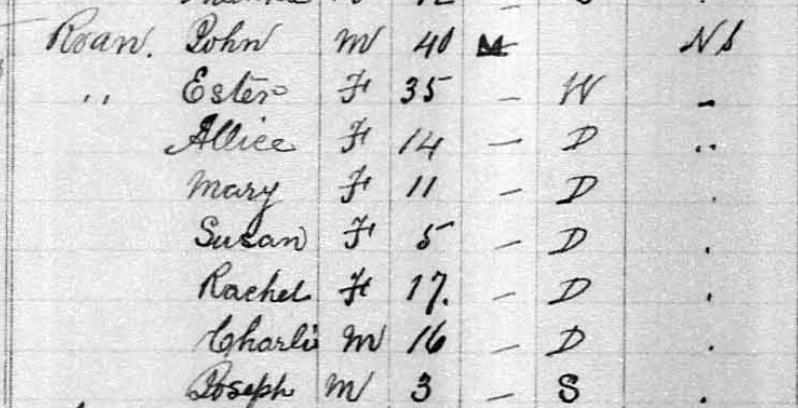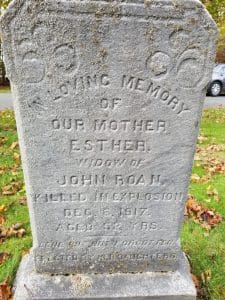 Written by Vicky, staff member, Halifax Central Library, opens a new window
Written by Vicky, staff member, Halifax Central Library, opens a new window
Halifax history is a mosaic of people with their own unique stories and experiences. Some of these people have become household names achieving notoriety for some great deed, or amazing success. But most people, for lack of a better term, would be considered “ordinary.” They lived regular lives, working hard to provide for their families, finding joy in contributing to their community in whatever way they could, and in doing so, helped build our city into what it is today. Let’s take a look at some of these regular people, and what we can learn about their lives in Halifax.
John and Esther ROAN (Carvery)
Esther Carvery was born on September 12, 1865, though some records date her birth much earlier.
Esther’s father, Alexander “Dar” Carvery (1825?-1929) worked as a general labourer. Her paternal grandfather, Eff Carvery (?-?), was from Preston, NS, and her paternal grandmother Rachael Hill (1801?–1901) was from Africa.
Esther’s mother, Emma (Emeline) Taylor (1843?–1902), looked after the Carvery household. Esther’s maternal grandfather was Edward Taylor (?-?); through available records, her maternal grandmother could not be found. Esther had twelve siblings.
From at least 1870, the Carvery family is listed as living at Campbell Road at their home in Africville, also known as the Campbell Road Settlement.
Sometime in her youth, Esther met and married John Roan. John’s history was difficult to trace. His parents are not known; some records list him as having been born in New Brunswick, others in Preston, NS, another in Bedford, NS, another simply said “U.S.” Even the year he was born was uncertain, with some sources listing it as early as 1844, and others saying as late as 1851. However, his decedents state that he was of Mexican heritage, and settled in Preston Township after arriving in Nova Scotia. Together. John and Esther had at least five children: Rachel, Charles, Susan, Alice, and Mary. Another son, Joseph, is listed in the 1891 census, but no record of him can be found thereafter. It is possible, as Charles’ middle name is Joseph, that this was a mistake by the census taker.
According to Halifax City Directories and Canada Census information, John worked a number of jobs throughout his life. Between 1871 and 1881 he is noted as being a mariner, a roofer, a truckman, a teamster, and a general labourer. Though the careers of women were not always noted on official documentation, Esther is an exception with two occupations to her credit: a midwife, and later in life a washerwoman.
The family were Baptists, and in all likelihood attended the Campbell Road Baptist Church, which had been established in Africville by Minister Richard Preston in the mid-1800s.
Tragedy strikes
In 1896, tragedy struck the family when John was taken ill with Phthisis, or tuberculosis. Tuberculosis is a highly infectious disease that can affect the body with a number of symptoms, including fatigue, weight loss, infections, and coughing, which in extreme cases can result in coughing up blood. Dr. William D. Finn, whose office was at 100 Argyle Street, was John’s attending physician. Unfortunately, John was unable to fight off the illness, and passed away on January 29. John was buried in Preston, Nova Scotia.
Though no doubt distressed by her husband’s death, Esther had a family to care for. Throughout the early 1900s she continued raising her children in Africville. In the 1901 Canada Census, she is shown living with her children, as well as her daughter-in-law Louise (Florence Louisa Chandler), who married Esther’s son Charles in June of 1898. As time went on, Esther’s other children would go on to start their own families and live their own lives: in 1901, Mary was wed to Allan Dixon; in 1910, Alice married William Rowe; Susan was married to Richard Johnson; Rachel, the oldest daughter, never married; as mentioned previously, there is no additional information about Joseph. Unfortunately, Charles’ life was cut short in 1907 when, like his father, he too passed away due to complications related to tuberculosis.
Family living
By 1911, with her children grown, Esther had moved in with her daughter Susan, her husband, and their four children: Mary, Rachel, Richard, and Etta. According to the census records, Esther and the Johnson family lived in a home between the properties of George Carvery and William Howe, which would have placed them somewhere in the circled portion of the map above. The map indicates that George Carvery and William Howe owned properties on both sides of Campbell Road, so it is uncertain which side of the street Esther and the Johnsons lived on. At this time, Esther was working as a washerwoman for the North End City Mission located at the corner of Gerrish and Maynard Streets. Though the tragedies of John and Charles’ deaths were certainly not forgotten by the family, nothing could have prepared them for what was coming six short years later.
A fateful Halifax day
On December 6, 1917, the Norwegian supply ship Imo and the French munitions ship the Mont-Blanc, collided in the harbour resulting in the biggest man made explosion prior to the discovery of the atomic bomb; thousands were wounded, nearly 2000 died. Unlike the Richmond area of Halifax and the Tuft’s Cove area of Dartmouth that were levelled by the detonation, Africville was comparatively spared from the destruction of the blast. A nearby hill helped shield the community, and though there was certainly damage to property, it was not as brutal as other areas of the city. Five people from Africville died as a result of the explosion; unfortunately for the Roans, Esther was one of them.
Gone, but not forgotten
Though it cannot be known for sure, it is possible that Esther was on her way, or already at work at the North End City Mission, when the explosion occurred. This would have placed her much closer to the heart of the blast, and might explain why she was one of only a handful of Africville residents who lost their lives. While her exact injuries are unknown, documents show that she was taken to Truro to receive medical attention. Unfortunately, her injuries were too severe, and she died of shock that same day. Her daughter Mary was brought in to identify her, and Esther was returned to Halifax for burial. She was laid to rest in Fairview Lawns Cemetery, with her daughters erecting a headstone to honour her legacy.
In the eyes of history, John and Esther Roan would perhaps be considered “ordinary” Halifax citizens. They were not wealthy, nor were they great entrepreneurs, or world renowned entertainers, but that does not mean they were insignificant. Their decedents, many of whom still live in the HRM, remember their story, and now you will too. As it says on Esther’s memorial: “Gone, but not forgotten”.
Special Thanks to the Africville Museum, Paula Smith, and Beatrice Wilkins for their assistance with this blog.
Online Resources
The Canadian Encyclopedia: Halifax Explosion
The Canadian Encyclopedia: Tuberculosis
Nova Scotia Archives:
https://archives.novascotia.ca/africanns/archives/?ID=10
https://archives.novascotia.ca/directories/list/







Add a comment to: Our People, Our Community: The Lives of Haligonians – John and Esther Roan (Carvery)